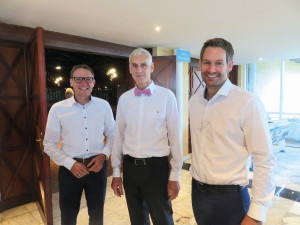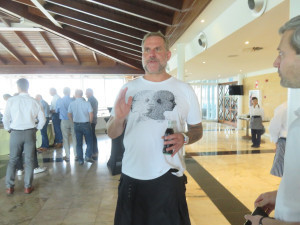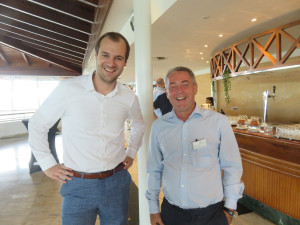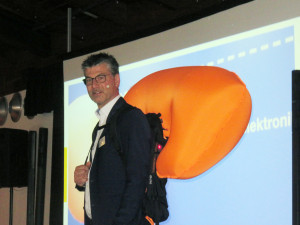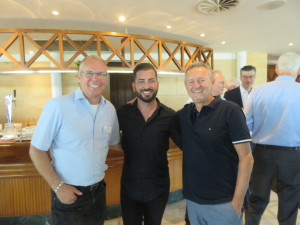The presentations at the 23rd European Electronics Technology College (EE College) in the town of Colonia de Sant Jordi on Mallorca used examples to show what is already possible in terms of pole position and where the technology is heading.
As in previous years, the European Electronics Technology College was organized by the companies ASM Assembly Systems, ASYS Automatisierungssysteme, Balver Zinn Josef Jost, Christian Koenen, kolb Cleaning Technology, Rehm Thermal Systems and Zevac. New concepts and ideas were discussed intensively during networking, an important element of the college. Dr. Hans Bell was once again the moderator.
At the opening, Dr. Hans Bell addressed the current generally critical situation and cited some examples of what was written in the Stralsund newspaper a hundred years ago - even then there was an economic crisis and extreme inflation. But the technology has developed rapidly: for example, TSCM is now used for Apple nanometer structures.
Communication is crucial for simultaneous engineering
In the first presentation entitled "Simultaneous Engineering - How an EMS company successfully develops products", Hubert Kraus, Zollner Elektronik AG, Zandt, emphasized at the beginning: "Agile is not chaotic." Successful simultaneous engineering requires adapted processes with additional documentation of what is necessary. Hubert Kraus illustrated the project process using the hybrid agile V-model applied at Zollner Elektronik. A decisive factor in this is intensive communication between all those involved, which also requires physical proximity and is implemented in his company in exactly the same way.
Robot technology in the electronics industry
Stefan Wespel, Diehl AKO, reported on the use of robot technology in the electronics industry - experience at Diehl Controls. He also discussed the development of the production structure. The classic SMT, THT and test field systems are already integrated into an all-encompassing line at Diehl. The vision is that everything else will also be fully automated. This is why robot projects are underway for packaging, THT assembly and standardization of the robot cells. Diehl now has four placement robots and one in the packaging area in successful operation.
CO2-neutral production with secondary raw materials
The presentation by Dan Mutschler, MTM Ruhrzinn, showed how secondary raw materials can be used to achieveCO2-neutral production. He showed that secondary raw materials are the better materials because they are of the same quality and also have a significantly better environmental footprint. The production of pure tin from solder residues (dross, obsolete solder pastes, etc.) requires only around one hundredth of the energy needed for extraction and production from ores. The same applies to many other metals such as gold. Dan Mutschler also explained what support his company offers for taking back waste from electronics production.
Digital twin and simulation in electronics production
Ulf Oestermann, Fraunhofer IZM, explained the possibilities of the digital twin in electronics production in his inimitable way. Diversity and complexity are characteristic of modern electronics manufacturing, which is a major challenge for digitalization and, in particular, for the creation and application of digital twins. This is because not everything can be simulated due to the effort involved and the problems caused by unfavorable design cannot be solved. Ulf Oestermann used examples to demonstrate the limits.
Reinhardt Seidel, FAPS, provided information on the development of optimized SMT and THT processes with the help of simulation. Because simply applying design rules is the wrong approach. Using the example of solder penetration in selective soldering, he illustrated what simulation can achieve here, but also the effort required. It takes several days to create a model of a 3D solder joint and to model and simulate the soldering process. A new Smart Selective app that works with AI facilitates the optimal design of the solder joints.
Market situation and technology trends for printed circuit boards
The first day of lectures ended with a presentation by Dr. Christoph Lehnberger, Andus Electronic GmbH, Berlin, on the market situation, technology trends and new applications for printed circuit boards. After discussing the development of market data since 2020, Dr. Christoph Lehnberger used examples from his company to explain the current technology trends. These include 3D structures, new processes such as digital printing, new HF materials, power PCBs and new applications in the THz range and radio telescopy.
ESD protection during assembly
Prof. Dipl.-Ing. Peter Jacob, Empa Swiss Federal Laboratories for Materials Science and Technology, Dübendorf, Switzerland, looked at the ESD risks in assembly systems as well as new measurement methods and ESD remedial measures, referring to the corresponding guideline RL 1013 of the ESD-Forum e. V.. Today, ESD protection is mainly a problem of ever faster automatic process machines. For example, the main part of the electrical charge is generated during placement when the components are released/separated from the placement tool during placement on the PCB. Ionizers integrated into the machines can provide a remedy here, as explained.
Added value through process diversity
Dr. Richard Scheicher, BMK Group GmbH, Augsburg, made it clear that box-build creates added value through process diversity. This is because potting, siliconizing, coating, assembly etc. are becoming standard in professional electronics production. In a video, he showed the assembly cells set up for this purpose in his company. This allows products to be completely manufactured for customers, which he also demonstrated using the example of an avalanche airbag.
Package footprints
Dr. Frank Steinhäußer, Infineon Technologies AG, Regensburg, provided information on modern package footprints - requirements and trends, with a focus on bottom termination components (BTC). The design of the footprints (solder surface pattern) has an influence on the wetting of the connections with solder and the self-centering of the components during soldering as well as on the results of the AOI. He recommended using the optimized footprints created by the component manufacturer. These footprints can be downloaded from the components' websites.
New possibilities with heated PCBs
In the last lecture, Dr. Dirk Seehase, IEF/IGS at the University of Rostock, presented new possibilities for reliability testing using heated PCBs. Heating is achieved by means of layers of resistive and inductive materials applied to the printed circuit boards. The latter were described and their possible applications, which extend to soldering and also include qualification tests, were listed.
The 23rd European Electronics Technology College ended with a discussion in which questions were answered. This and the networking discussions showed that new concepts and ideas as well as an intensive exchange are still in demand.


